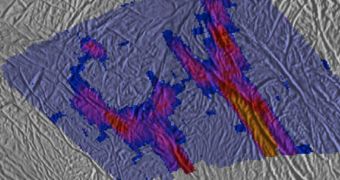A group of researchers analyzing data sent back by the NASA Cassini spacecraft announce that studies of the fissures on the surface of the Saturnine moon Enceladus revealed an unexpected complexity.
The formations are also warmer than the space probe initially led astronomers to believe. The images and data used for the research were collected during an August flyby the orbiter did around the moon.
For years, Enceladus has captured the imagination of astronomers, as it represents one of the most interesting places in the solar system. Its south pole is of special interest, because it contains active geysers that spew out water vapors and organic particles.
Many planetary scientists now believe that an ocean of liquid water may exist kilometers beneath the frozen surface of the moon. Cassini studies are now focused on understanding the inner dynamics of the celestial body, as well as the mechanisms that power up the jets.
The southern geyser-spewing fractures, which resemble tiger stripes in appearance, are warmer and more complex that initial datasets suggested, Cassini scientists now propose.
“The exquisite resolution obtained on one segment of the Damascus fracture – one of the most active regions within the south polar terrain – has revealed a surface temperature reaching a staggering 190 Kelvin, or 120 degrees below zero Fahrenheit,” said Carolyn Porco.
In an email announcing the new conclusions, the leader of the Cassini imaging team also added that “far from the fractures, the temperature of the south polar terrain dips as low as 52 Kelvin, or 365 degrees below zero Fahrenheit.”
The only logical conclusion that can be drawn from this is that large amounts of heat escape from the moon's interior through the fissures in its surface.
In fact, it could be that the tiger stripes themselves are “the result of the tidal flexing of Enceladus brought about by its orbital resonance with [fellow Saturnine moon] Dione,” Porco revealed.
“However, details of this heating process are still unclear and are being studied at this very moment,” she went on to say.
Investigators on the new study add that infrared spectroscopy studies carried out during the August 13 flyby were doubled by high resolution images, which allowed for the construction of the most detailed heat intensity map of the moon's South Pole to date.
“The ends of the tiger stripes may be the places where the activity is just getting started, or is winding down, so the complex patterns of heat we see there may give us clues to the life cycle of tiger stripes,” explains John Spencer.
He holds an appointment as a Cassini team scientist, and is based in Boulder, Colorado, at the Southwest Research Institute (SwRI).
An important conclusion of the flyby was that the tiger stripes were more tectonically dynamic than initially thought, which in turn means that Enceladus' interior is more active.
A new flyby of the moon took place yesterday, November 30, and Cassini scientists are currently downloading the data. These new information will be included in the existing maps, in order to make them even more detailed than before, Universe Today reports.

 14 DAY TRIAL //
14 DAY TRIAL //